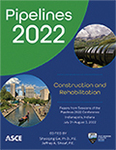Leak Detection of Pipelines for the City of Stillwater Using Wide Area Multispectral Remote Sensing Technology
Publication: Pipelines 2022
ABSTRACT
The City of Stillwater, Oklahoma, owns and operates a transmission pipeline over a 36-mi corridor from Kaw Reservoir to the city’s treatment plant. This pipeline is a 36-in. carbon steel pipe built in 1981 to an API 5L specification. Over the last two decades, the pipeline has shown signs of distress and required various leak repairs. Since this transmission pipeline is integral to the city’s water supply, there is an immediate need to determine the extent of the leakage problem. It was determined that by using airborne remote sensing techniques such as Jacobs’ wide area multispectral system technology, data can be gathered relatively quickly to analyze and provide an indication of potential leaks in the existing pipeline. In August 2021, several passes with an airplane were conducted along the length of the pipeline using Jacobs’ wide area multispectral system. Thermal imagery was captured via a long wave infrared (LWIR) sensor, which identifies thermal radiation emitted from the ground, giving a measure of ground temperature over a wide area. Vegetation has a very high near-infrared response, and as a result, a calculated quantity called the normalized difference vegetation index (NDVI) is used to detect the presence, density, and health of vegetation utilizing the blue, green, red, and near infrared bands (BGRN). A water index is generated applying the triangle method, originally presented by Water-Tightness Airborne Detection Implementation (WADI). When applied to the imagery, it can reveal areas of water or wetness that is created by a leak in the pipeline. The generated water index looks at a pixel’s NDVI and temperature and compares it to all other pixels with the same or similar NDVI. Both wet areas and vegetation have a similar temperature profile (usually cooler than the surroundings) but have a different NDVI, with vegetation scoring high and wet areas having NDVI of nearly zero. Water index calculations use NDVI to distinguish between the wet areas and vegetation, hence enabling identification of active leaks along the pipeline. This paper presents the findings and discussions provided as part of the investigation. These discussions assist the city with future improvements, including rehabilitation or replacement of existing transmission pipeline. It also provides the city with expedient information about existing pipeline integrity to perform immediate repairs, if indicated.
Get full access to this article
View all available purchase options and get full access to this chapter.
REFERENCES
Chatelard, C., J. S. Muñoz, C. Mazel, J.-C. Krapez, P. Barillot, F. Helias, Y.-M. Frederic, and J. Barba Polo. (2019). “Leak detection in water transmission systems by multispectral remote sensing with airplane and UAV”. Presented at 2019 IEEE International Geoscience and Remote Sensing Symposium. Yokohama, Japan.
MicaSense. (2021). OSAVI (Optimized Soil-Adjusted Vegetation Index). Accessed July 20. https://support.micasense.com/hc/en-us/articles/227837307-Overview-of-Agricultural-Indices#osavi.
Information & Authors
Information
Published In
History
Published online: Jul 28, 2022
Authors
Metrics & Citations
Metrics
Citations
Download citation
If you have the appropriate software installed, you can download article citation data to the citation manager of your choice. Simply select your manager software from the list below and click Download.
